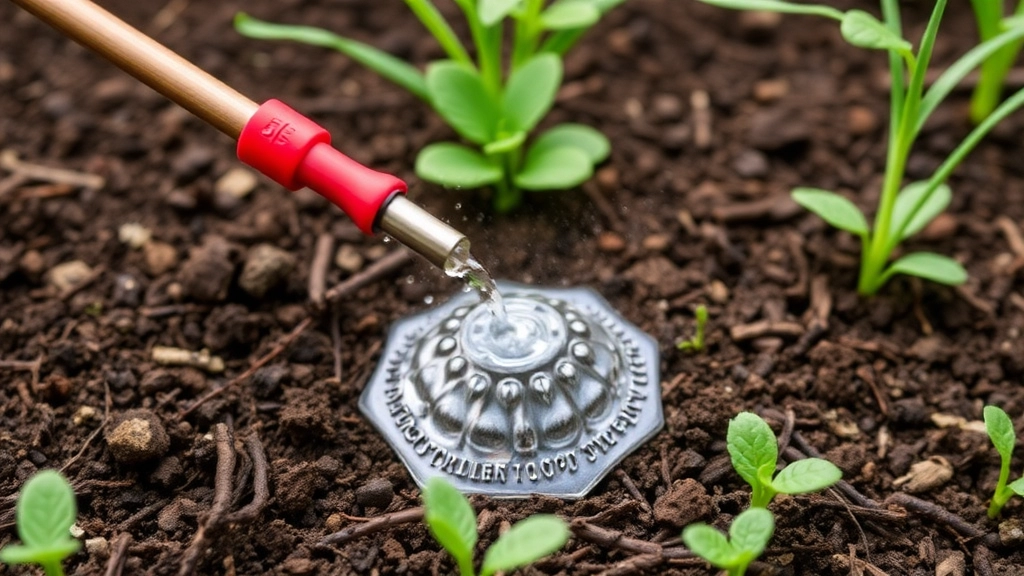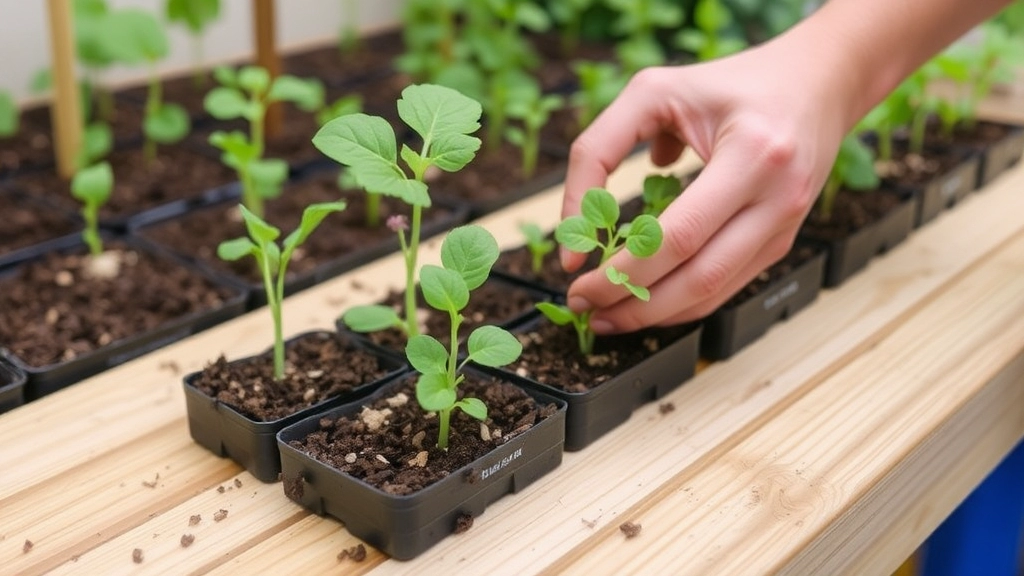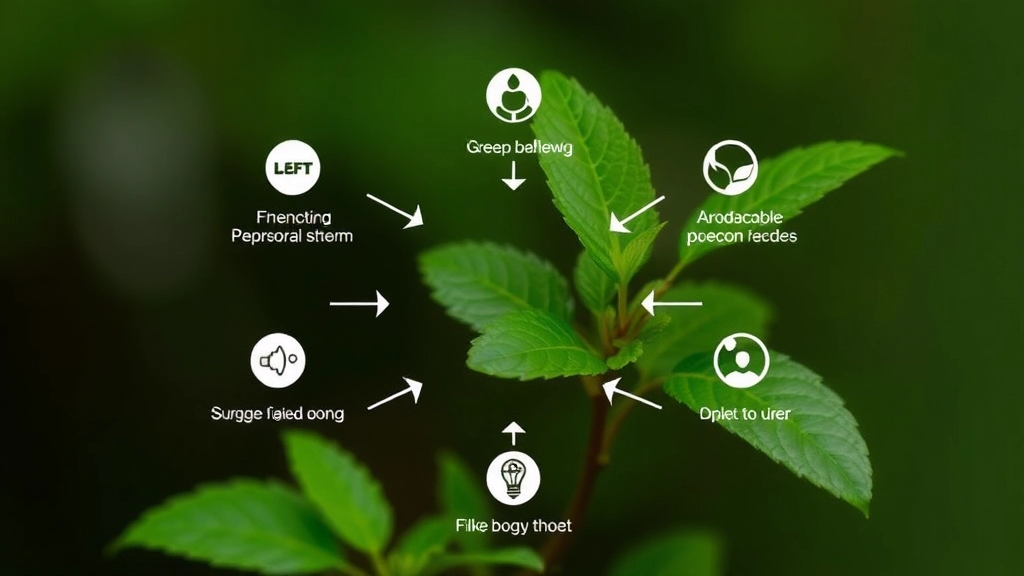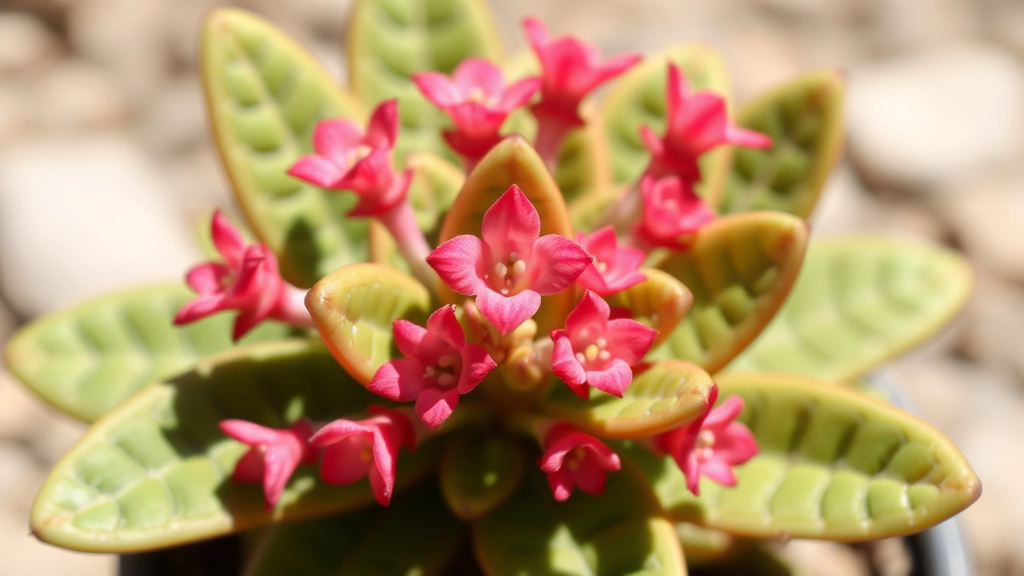Discover Kalanchoe Lateritia
Discover the captivating world of Kalanchoe lateritia, a stunning succulent that’s as resilient as it is beautiful. In this comprehensive guide, we’ll explore everything from its unique characteristics and natural habitat to expert care tips that will help your plant thrive. Whether you’re a seasoned plant parent or a curious beginner, you’ll find valuable insights on cultivating this Madagascar native.
From its drought-tolerant nature to its vibrant, tubular blooms, Kalanchoe lateritia is a true gem in the world of succulents. We’ll delve into its light preferences, watering needs, and propagation methods, ensuring you have all the tools to nurture a healthy, flourishing plant. Get ready to embark on an exciting journey with this low-maintenance yet show-stopping succulent!
Description and Characteristics of Kalanchoe lateritia
Ever heard of Kalanchoe lateritia? It’s a pretty cool succulent.
Let’s chat about what makes this plant unique.
First off, it’s part of the Crassulaceae family – fancy name, I know.
But here’s the fun part: it’s got these thick, fleshy leaves that are kinda oval-shaped.
The leaves? They’re a deep green, sometimes with a reddish tinge.
Now, the flowers are where it gets really interesting.
They’re these vibrant, tubular blooms that hang down in clusters.
Usually, they’re a bright orange-red colour – proper eye-catching stuff.
The plant itself? It can grow up to about 60cm tall.
It’s got this upright, bushy habit that makes it look pretty neat in a pot.
One cool thing about Kalanchoe lateritia is its drought tolerance.
It’s a tough cookie, storing water in those chunky leaves.
This makes it a great low-maintenance option for busy plant parents.
But don’t let that fool you – it’s not just easy, it’s also stunning.
When it’s in full bloom, it’s like having a little firework display in your living room.
So, if you’re after a plant that’s both hardy and a showstopper, Kalanchoe lateritia might be your new best mate.
Natural Habitat and Distribution
Alright, let’s dive into the natural habitat and distribution of Kalanchoe lateritia. This succulent’s got some interesting roots, literally and figuratively.
Where Does Kalanchoe lateritia Call Home?
Kalanchoe lateritia is a native of Madagascar, that big island off the coast of Africa. It’s like the succulent hit the jackpot with its birthplace. Madagascar’s got this wild mix of climates and terrains, perfect for a plant that likes to keep things interesting.
The Madagascar Connection
Picture this: rugged mountains, dry forests, and coastal areas. That’s where you’ll find Kalanchoe lateritia living its best life. It’s adapted to survive in some pretty tough spots, which is why it’s such a champ when we grow it in our homes.
Spreading Its Roots
While Madagascar is home base, Kalanchoe lateritia has become a bit of a globetrotter. Thanks to plant enthusiasts (yeah, that’s us), it’s now found in:
- Tropical regions around the world
- Botanical gardens (showing off, as usual)
- Home collections from Europe to the Americas
Why It Thrives Where It Does
Kalanchoe lateritia is like that friend who’s always prepared. It’s got some tricks up its sleeve:
- Thick, fleshy leaves to store water
- A knack for growing in rocky, well-drained soils
- Tolerance for both sun and partial shade
These adaptations make it a survivor in its natural habitat and a star in our gardens.
What This Means for Growers
Understanding where Kalanchoe lateritia comes from is key to keeping it happy in our homes. It’s not just about mimicking Madagascar (though that’d be cool). It’s about giving it the essentials:
- Well-draining soil (think cactus mix)
- Bright light, but not scorching sun
- A break from watering now and then
By tapping into its natural preferences, we can help our Kalanchoe lateritia thrive, even far from its Madagascar roots. If you’re interested in other Kalanchoe species, you might want to check out the Kalanchoe blossfeldiana succulent, which is another popular variety.
Remember, knowing where Kalanchoe lateritia naturally grows isn’t just trivia. It’s your cheat sheet for keeping this succulent happy and healthy, whether you’re in London or Los Angeles. For more information on caring for different Kalanchoe species, you can explore our guide on Kalanchoe blossfeldiana hybrid care.
Cultivation Requirements
Alright, let’s chat about growing Kalanchoe lateritia. It’s not rocket science, but there are a few things you’ll want to keep in mind.
First off, these succulents are pretty chill when it comes to care. But they do have some preferences.
Soil: What’s the deal?
- Well-draining soil is your best mate here
- Mix regular potting soil with some sand or perlite
- Aim for a slightly acidic to neutral pH
Container: Choose wisely
- Pick a pot with drainage holes
- Terracotta works great – it helps prevent overwatering
Location: Where to put your plant?
- Bright, indirect light is the sweet spot
- A south-facing window is usually a winner
Temperature: Keep it cosy
- These guys like it warm – think 15-24°C (59-75°F)
- Not fans of frost, so keep ’em inside when it’s chilly
Humidity: No sweat
- Average room humidity is fine
- They’re not fussy about moisture in the air
Feeding: Don’t go overboard
- Use a balanced, water-soluble fertiliser
- Feed every 4-6 weeks during growing season
- Skip the feed in winter
Remember, Kalanchoe lateritia is pretty forgiving. Even if you’re not a green thumb, you’ve got a good shot at keeping these beauties happy.
Just give ’em the basics, and they’ll do their thing. Easy peasy, right?
Watering and Soil Needs

Alright, let’s dive into the nitty-gritty of keeping your Kalanchoe lateritia happy and thriving. Trust me, getting the watering and soil right is like hitting the jackpot for these succulents.
Watering: Less is More
Here’s the deal with watering Kalanchoe lateritia:
- Think desert, not rainforest
- Let the soil dry out completely between waterings
- In summer, water every 2-3 weeks
- In winter, cut back to once a month
I learned this the hard way when I first got my Kalanchoe. I thought, “Plants need water, right?” Wrong! I nearly drowned the poor thing. Now, I stick my finger in the soil – if it’s dry up to my knuckle, it’s watering time.
Soil: Gritty is Pretty
For soil, imagine you’re creating a five-star resort for your Kalanchoe lateritia:
- Use a well-draining cactus or succulent mix
- Add some perlite or coarse sand for extra drainage
- Aim for a pH between 6.0 and 7.5
I once tried to grow my Kalanchoe in regular potting soil. Big mistake! It was like trying to run a marathon in flip-flops – just doesn’t work. The plant got all soggy and sad. Now, I mix my own gritty soil, and my Kalanchoe is living its best life.
Pro Tip: Drainage Holes are Your BFF
Make sure your pot has drainage holes. It’s like giving your Kalanchoe watering an escape route from excess water. No holes? You’re asking for root rot, and trust me, that’s a party no one wants to attend.
Remember, when it comes to Kalanchoe lateritia, think dry and gritty. Get these basics right, and you’re well on your way to succulent success. Now, who’s ready to get their hands dirty? If you’re interested in expanding your Kalanchoe collection, you might want to check out the types of Kalanchoe tomentosa available.
Light and Temperature Preferences
Let’s chat about Kalanchoe lateritia’s light and temp needs.
These succulents are sun-lovers, no doubt about it.
But here’s the thing – they’re not fans of scorching direct sunlight all day.
Think of them as beach-goers who enjoy the sun but need a bit of shade too.
Bright, indirect light is their sweet spot.
Got a south-facing window? Perfect. Just pop a sheer curtain up for filtered light.
Now, temperature-wise, these guys are pretty chill (pun intended).
They’re cool with average room temps, around 15-24°C (59-75°F).
But here’s a pro tip: they can handle a bit of cold, down to about 10°C (50°F).
Just don’t let them freeze, alright?
In summer, they might need a holiday from intense heat.
If it’s sweltering outside, give ’em a break indoors.
Remember, these plants are tough cookies, but they’re not invincible.
Too much heat or cold can stress them out.
And stressed plants? They’re like stressed humans – not looking their best.
So, keep an eye on your Kalanchoe lateritia.
If it’s looking a bit pale or leggy, it might need more light.
Scorched leaves? That’s a sign it’s getting too much sun.
Bottom line: Kalanchoe lateritia likes it bright but not too hot.
Find that sweet spot, and you’ll have a happy, thriving plant on your hands.
Propagation Methods

Alright, let’s dive into how we can make more of these Kalanchoe lateritia beauties. Trust me, it’s easier than you might think!
Leaf Cuttings: The Lazy Gardener’s Dream
You know what’s cool about Kalanchoe lateritia? You can grow a whole new plant from just a leaf. Here’s how:
- Snip off a healthy leaf
- Let it dry for a day or two (this helps prevent rotting)
- Stick it in some well-draining soil
- Water lightly and wait
Before you know it, you’ll see tiny roots and leaves popping up. It’s like magic, but it’s just plant science doing its thing.
Stem Cuttings: For When You Want Results Fast
If you’re impatient like me, stem cuttings are your best bet:
- Cut a 4-6 inch stem just below a leaf node
- Remove the lower leaves
- Let it callous over for a day
- Plant in moist, well-draining soil
- Keep it warm and slightly humid
Pro tip: Use a rooting hormone if you want to speed things up even more. It’s like giving your cutting a little growth boost.
Division: The “Two Birds, One Stone” Method
Got a big, bushy Kalanchoe lateritia? Here’s how to turn one plant into many:
- Carefully remove the plant from its pot
- Gently separate the roots into smaller clumps
- Replant each section in its own pot
This method’s great because you get multiple mature plants right off the bat. Plus, it helps rejuvenate your original plant. Win-win!
Seeds: For the Patient Plant Parent
Growing from seeds is like watching paint dry, but hey, some folks enjoy the process:
- Sow seeds on the surface of well-draining soil
- Keep them warm and moist
- Wait… and wait some more
It’ll take a while, but there’s something satisfying about nurturing a plant from seed to full-grown beauty.
Remember, whichever method you choose, Kalanchoe lateritia is pretty forgiving. Just give it some love, and it’ll do its thing. Before you know it, you’ll have enough plants to start your own little Kalanchoe jungle! If you’re interested in other Kalanchoe varieties, check out the Kalanchoe blossfeldiana flowering period or learn about the white variety of Kalanchoe tomentosa.
Common Pests and Diseases
Let’s chat about the bugbears that can mess with your Kalanchoe lateritia, shall we?
These succulents are pretty tough cookies, but they’re not invincible.
Mealybugs: The Sneaky Invaders
Ever spotted little white fuzzy spots on your plant? That’s mealybugs for you.
These tiny pests love to suck the life out of your Kalanchoe.
Quick fix? Dab ’em with a cotton swab soaked in rubbing alcohol. Works like a charm!
Aphids: The Green Menace
These little green monsters can multiply faster than you can say “Kalanchoe”.
They’re like tiny vampires, draining your plant’s sap.
Spray ’em off with a strong jet of water or use insecticidal soap if they’re being stubborn.
Root Rot: The Underground Threat
This is what happens when you love your Kalanchoe a bit too much with water.
Soggy soil = happy fungi = sad plant roots.
Prevention is key here. Make sure your pot has drainage holes and let the soil dry out between waterings.
Powdery Mildew: The White Plague
Spot a white, powdery coating on the leaves? That’s powdery mildew.
It loves humid conditions and poor air circulation.
Neem oil is your best mate here. Spray it on and watch the mildew disappear.
Remember, a healthy Kalanchoe lateritia is less likely to fall victim to these pests and diseases.
Keep it in tip-top shape with proper care, and you’ll be laughing.
Got any pest problems with your Kalanchoe lateritia? Drop a comment and let’s troubleshoot together!
Benefits and Uses

Alright, let’s dive into the good stuff about Kalanchoe lateritia. This little plant’s not just a pretty face, it’s got some serious perks up its sleeve.
Aesthetic Appeal
First off, let’s talk looks. Kalanchoe lateritia is a stunner, no doubt about it. With its vibrant orange-red flowers and thick, fleshy leaves, it’s like having a mini sunset in your living room. I’ve got one on my desk, and let me tell you, it’s a real mood-booster when I’m knee-deep in work.
Air Purification
But here’s where it gets interesting. Like many succulents, Kalanchoe lateritia is a natural air purifier. It’s not just sitting there looking pretty; it’s actively cleaning the air you breathe. How cool is that?
Low Maintenance Greenery
Now, for all you busy bees out there (and trust me, I get it), this plant is a dream come true. It’s like the low-maintenance friend of the plant world. Forget to water it for a week? No worries, it’ll forgive you. It’s perfect for:
- Office spaces
- Apartments
- Dorm rooms
- Anywhere you want some green without the hassle
Medicinal Properties
Here’s a fun fact: some Kalanchoe species have been used in traditional medicine. While I’m not saying to go chewing on your Kalanchoe lateritia (please don’t), it’s interesting to know its cousins have some healing cred. For instance, Kalanchoe pinnata has spiritual uses in some cultures.
Stress Reduction
Last but not least, let’s talk stress. Having plants around can seriously chill you out. I’ve noticed I’m way more relaxed when I’m surrounded by my green buddies, including my trusty Kalanchoe lateritia.
So, there you have it. Kalanchoe lateritia isn’t just a pretty face; it’s a hardworking, air-cleaning, stress-busting little powerhouse. Whether you’re a plant newbie or a green thumb pro, this plant’s got something for everyone. And let’s be real, in today’s world, couldn’t we all use a bit more of what Kalanchoe lateritia’s offering? If you’re interested in exploring other varieties, you might want to check out the variegated Kalanchoe blossfeldiana for a unique twist on the classic.
Seasonal Care Tips for Kalanchoe lateritia
Ever wondered how to keep your Kalanchoe lateritia thriving all year round?
Let’s dive into some no-nonsense seasonal care tips that’ll make your plant the envy of the neighbourhood.
Spring: Time to Wake Up
- Give your Kalanchoe a good once-over
- Trim any dead or weak stems
- Start increasing watering as growth picks up
- Consider repotting if it’s outgrown its current home
Summer: Livin’ It Up
- Water more frequently, but don’t go overboard
- Protect from scorching midday sun
- Feed with a balanced fertiliser every 2-3 weeks
- Watch out for pests – they love the warm weather too
Autumn: Winding Down
- Gradually reduce watering
- Stop fertilising
- Move to a brighter spot as days get shorter
- Prepare for potential blooming
Winter: Chill Time
- Water sparingly – once every 2-3 weeks might do
- Keep away from cold drafts and heating vents
- Enjoy the flowers if they decide to show up
- Hold off on pruning until spring
Remember, Kalanchoe lateritia is pretty chill, but it’ll thank you for these seasonal tweaks.
Got any Kalanchoe care hacks? I’d love to hear ’em!
Frequently Asked Questions about Kalanchoe lateritia
Let’s dive into some burning questions about Kalanchoe lateritia, shall we? I’ve been growing these beauties for years, and I’ve heard it all. So, let’s cut through the noise and get to the good stuff.
Is Kalanchoe lateritia toxic to pets?
Yep, it’s a bummer, but these plants are toxic to cats and dogs. If you’ve got furry friends at home, keep your Kalanchoe out of reach. Trust me, it’s not worth the vet bill or the worry.
How often should I water my Kalanchoe lateritia?
Here’s the deal: these guys are succulents, so they’re pretty chill about water. I water mine once the soil’s completely dry. In summer, that might be weekly. In winter, maybe every two weeks. Just stick your finger in the soil – if it’s dry, give it a drink.
Can Kalanchoe lateritia survive outdoors?
Sure can! But only if you live somewhere warm. These plants love temperatures between 15-25°C (59-77°F). If you’re in a cooler spot, bring them inside when it gets chilly.
Why are my Kalanchoe lateritia leaves turning yellow?
Uh-oh, yellow leaves. Usually, it’s one of three things:
- Overwatering (most common)
- Not enough light
- Nutrient deficiency
Check your watering habits first. If that’s not it, move it to a brighter spot or give it a feed.
How do I propagate Kalanchoe lateritia?
Easy peasy! Just snip off a leaf or stem cutting, let it dry for a day or two, then stick it in some well-draining soil. Keep it moist but not soggy, and you’ll have a new plant in no time.
Why isn’t my Kalanchoe lateritia flowering?
If your Kalanchoe’s being shy about blooming, it might need:
- More light (they love bright, indirect sunlight)
- A period of darkness (12-14 hours a day for about 6 weeks)
- Less fertiliser (too much nitrogen can discourage flowering)
How big does Kalanchoe lateritia grow?
These aren’t massive plants. They usually top out at about 30-60 cm (12-24 inches) tall. Perfect for a windowsill or small space.
Can I grow Kalanchoe lateritia indoors?
Absolutely! They’re great indoor plants. Just make sure they get enough light and don’t overwater them. They’re pretty low-maintenance, which is why I love ’em.
How long does Kalanchoe lateritia live?
With proper care, these plants can live for several years. I’ve had some for over 5 years now. Just keep them happy with the right light, water, and occasional feeding.
Remember, growing Kalanchoe lateritia isn’t rocket science. They’re pretty forgiving plants. Just give them some love, don’t drown them, and they’ll reward you with beautiful blooms. Any other questions about Kalanchoe lateritia? Fire away!
Frequently Asked Questions about Kalanchoe lateritia
How do I know if my Kalanchoe lateritia is getting enough light?
A healthy Kalanchoe lateritia should have compact growth and vibrant green leaves. If it’s stretching or becoming leggy, it’s likely reaching for more light. Move it to a brighter spot, but avoid direct, harsh sunlight which can scorch the leaves.
Can Kalanchoe lateritia survive in low light conditions?
While Kalanchoe lateritia can tolerate lower light levels for short periods, it won’t thrive long-term. In low light, you’ll notice slower growth and fewer flowers. For best results, provide bright, indirect light.
How do I encourage my Kalanchoe lateritia to bloom?
To encourage blooming, provide a period of shorter daylight hours (about 12-14 hours of darkness) for about 6 weeks. Reduce watering and stop fertilizing during this time. This mimics natural conditions that trigger flowering.
Is Kalanchoe lateritia frost-hardy?
No, Kalanchoe lateritia is not frost-hardy. It’s native to Madagascar and prefers warm temperatures. If you live in an area with frost, make sure to bring your plant indoors when temperatures drop below 10°C (50°F).
How often should I repot my Kalanchoe lateritia?
Typically, you should repot your Kalanchoe lateritia every 2-3 years or when it outgrows its current pot. Spring is the best time for repotting. Use a pot that’s only slightly larger than the current one to avoid overwatering issues.
Can I use regular potting soil for my Kalanchoe lateritia?
While Kalanchoe lateritia can survive in regular potting soil, it’s not ideal. These plants prefer well-draining soil. Mix regular potting soil with perlite or coarse sand to improve drainage. Alternatively, use a commercial cactus or succulent mix.
How do I prune my Kalanchoe lateritia?
Prune your Kalanchoe lateritia after flowering to encourage bushier growth. Remove spent flower stalks and any dead or yellowing leaves. You can also pinch back the tips of stems to promote branching.
Why are the leaves of my Kalanchoe lateritia falling off?
Leaf drop can be caused by several factors including overwatering, underwatering, extreme temperature changes, or pest infestations. Check your watering habits first, ensure the plant isn’t in a drafty spot, and inspect for any signs of pests.
Can Kalanchoe lateritia be grown from seeds?
Yes, you can grow Kalanchoe lateritia from seeds, but it’s a slow process. Most gardeners prefer propagation by leaf or stem cuttings as it’s faster and easier. If you do use seeds, sow them on the surface of well-draining soil and keep them warm and lightly moist.
References
-
Kalanchoe lateritia information Crassulaceae.ch – Kalanchoe lateritia

